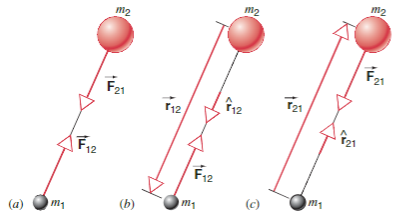The law of gravitation is an Inverse Square Law meaning that it varies proportionally to a distance squared.
The force of gravity is:
Where
In terms of Vectors, our law is:
and
Where
This is what the subscript represents.
the force of on , a vector pointing from to . represents the distance from to , a vector pointing from to .
And vice-versa for 
Note that
When there are more than two bodies, we can add vectors to find the total gravitational force for a mass.
For gravitation near the earth’s surface, we often use the free-fall acceleration from gravity
Many times we assume that
Where
There are also more irregularities:
- The density of the earth varies from point to point
- The earth itself is approximately an ellipsoid, not a sphere.
- The earth is rotating, shifting those irregularities constantly and creating a centrifugal force that varies based on latitude.
It is difficult to take the mass of every particle on earth and sum the gravitational force vectors from each to find a good gravitational force. However, using the first Shell Theorem:
A uniformly dense spherical shell attracts an external particle as if all the mass of the shell were concentrated at its center.
Link to original
We can represent the earth as a point mass located at its center (Its Center of Mass).
The distance